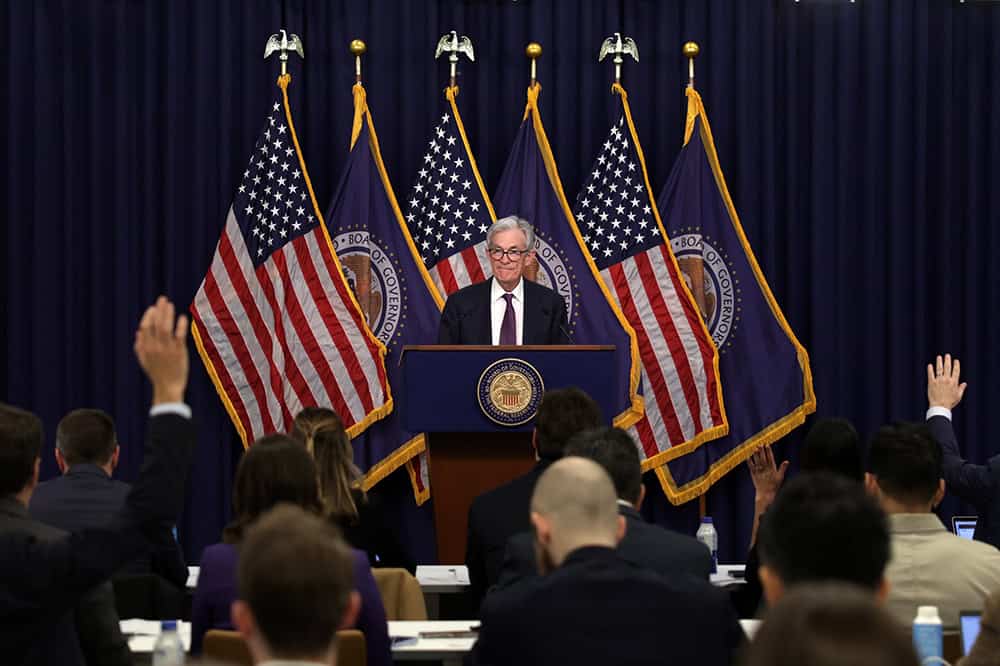As Lawmakers Pursue Infrastructure, Voters Remain Deeply Concerned about National Debt
The June 2021 Fiscal Confidence Index, Modeled after the Consumer Confidence Index, is 48 (100 is Neutral)
NEW YORK (June 29, 2021) — Amid this week’s announcement of a bipartisan infrastructure framework, and as lawmakers look ahead to a potential reconciliation bill, voters remain deeply concerned about the threat that the national debt poses to our nation’s future. The Peter G. Peterson Foundation’s monthly Fiscal Confidence Index, modeled after the Consumer Confidence Index, now stands at 48 (100 is neutral), indicating that voters want their leaders to prioritize fiscal responsibility as they work to make investments in America’s infrastructure.
Eight in 10 voters say that their concern about the national debt has increased over the past few years. The vast majority believe that the president and Congress should spend more time addressing the debt (82%, from 79% last month), driven by an increase among Democrats (76%, from 72% last month). More specifically, Americans broadly agree that the national debt should be a top-three priority for the president and Congress (75%, from 71% last month), with an eight-point jump among Democrats (66%, from 58% last month).
“Americans across party lines understand that fiscal responsibility is an essential component of effective leadership and policymaking,” said Michael A. Peterson, CEO of the Peterson Foundation. “While bipartisanship is important, so is our high and rising national debt. As the White House and lawmakers pursue a bipartisan infrastructure package and potentially a larger reconciliation bill, voters are calling for our leaders to pay for their priorities. Vast majorities of Americans understand that fiscal sustainability is essential for a stronger economy over the long term.”
The Fiscal Confidence Index measures public opinion about the national debt by asking six questions in three key areas:
- CONCERN: Level of concern and views about the direction of the national debt.
- PRIORITY: How high a priority addressing the debt should be for elected leaders.
- EXPECTATIONS: Expectations about whether the debt situation will get better or worse in the next few years.
The survey results from these three areas are weighted equally and averaged to produce the Fiscal Confidence Index value. The Fiscal Confidence Index, like the Consumer Confidence Index, is indexed on a scale of 0 to 200, with a neutral midpoint of 100. A reading above 100 indicates positive sentiment. A reading below 100 indicates negative sentiment.
Fiscal Confidence Index Key Data Points:
- The June 2021 Fiscal Confidence Index value is 48. (The May value was 43. The April value was 56.)
- The current Fiscal Confidence Index score for CONCERN about the debt is 48, indicating deep concern about the debt. The score for debt as a PRIORITY that leaders must address is 28, indicating that Americans want elected leaders to make addressing long-term debt a high priority. The score for EXPECTATIONS about progress on the debt is 67. The Fiscal Confidence Index is the average of these three sub-category scores.
- For a description of the complete methodology, see the Appendix below.
The Peter G. Peterson Foundation commissioned this poll by the Global Strategy Group and North Star Opinion Research to survey public opinion on the national debt. The online poll included 1,000 registered voters nationwide, surveyed between June 22, 2021 and June 24, 2021. The poll has a margin of error of +/- 3.1%. The poll examined voters’ opinions on the national debt, political leadership, and America’s fiscal and economic health.
Detailed poll results can be found online at: www.pgpf.org/FiscalConfidenceIndex.
About the Peter G. Peterson Foundation
The Peter G. Peterson Foundation is a nonprofit, nonpartisan organization that is dedicated to increasing public awareness of the nature and urgency of key fiscal challenges threatening America’s future, and to accelerating action on them. To address these challenges successfully, we work to bring Americans together to find and implement sensible, long-term solutions that transcend age, party lines and ideological divides in order to achieve real results. To learn more, please visit www.pgpf.org.
APPENDIX: Fiscal Confidence Index Methodology and Questions
- The Fiscal Confidence Index is released monthly by the Peter G. Peterson Foundation.
- The Fiscal Confidence Index value is based on six questions in three categories.
- As is done with the Consumer Confidence Index, the first step in calculating the Fiscal Confidence Index is determining the “Relative Value” for each question. This calculation is made by taking the positive response for each question and dividing it by the sum of the positive and negative responses. Each question was asked on a four-point scale, and answers were weighted according to intensity, with the strongest responses counting twice as much as the middle responses (“much” better or worse answers count twice as heavily as “somewhat” better or worse answers).
- The scores for the Concern, Priority, and Expectations categories are determined by averaging the scores derived from the two questions in each category.
- The Fiscal Confidence Index value is converted from the Relative Value to place it on a scale on which 100 indicates equal positive and negative sentiment, while values below 100 indicate negative sentiment and values above 100 indicate positive sentiment.
- The questions are as follows:
| CONCERN (48) | |||
|---|---|---|---|
| Thinking about our national debt over the last few years, would you say your level of concern has increased or decreased? ◊ Is that a lot or just a little? |
June 2021 | May 2021 | April 2021 |
| Increased a lot | 54% | 48% | 51% |
| Increased a little | 26% | 31% | 25% |
| Decreased a little | 4% | 5% | 6% |
| Decreased a lot | 4% | 3% | 4% |
| (No change) | 9% | 10% | 8% |
| (Don’t Know/Refused) | 4% | 4% | 6% |
| INCREASED (NET) | 80% | 79% | 75% |
| DECREASED (NET) | 8% | 7% | 10% |
| When it comes to addressing our national debt, would you say things in the United States are heading in the right direction or do you think things are off on the wrong track? ◊ Do you feel that way strongly or just somewhat? |
June 2021 | May 2021 | April 2021 |
| Right direction-Strongly | 16% | 13% | 20% |
| Right direction-Somewhat | 24% | 26% | 25% |
| Wrong track-Somewhat | 22% | 22% | 18% |
| Wrong track-Strongly | 32% | 33% | 30% |
| (Neither/Mixed) | 1% | 1% | 1% |
| (Don’t Know/Refused) | 4% | 5% | 6% |
| RIGHT DIRECTION (NET) | 41% | 39% | 45% |
| WRONG TRACK (NET) | 54% | 55% | 48% |
| PRIORITY (28) | |||
|---|---|---|---|
| Some people say that addressing the national debt should be among the president and Congress’ top 3 priorities. Do you agree or disagree? ◊ Do you feel that way strongly or just somewhat? |
June 2021 | May 2021 | April 2021 |
| Strongly agree | 50% | 46% | 51% |
| Somewhat agree | 25% | 24% | 19% |
| Somewhat disagree | 12% | 17% | 15% |
| Strongly disagree | 7% | 6% | 6% |
| (Don’t Know/Refused) | 6% | 7% | 9% |
| AGREE (NET) | 75% | 71% | 70% |
| DISAGREE (NET) | 19% | 22% | 21% |
| And when it comes to our national debt, do you think it is an issue that the president and Congress should spend more time addressing or less time addressing? ◊ Would you say a lot (more or less) time or just a little? |
June 2021 | May 2021 | April 2021 |
| A lot more time | 52% | 46% | 48% |
| A little more time | 30% | 33% | 29% |
| A little less time | 6% | 5% | 7% |
| A lot less time | 5% | 4% | 5% |
| (The same amount of time) | 3% | 6% | 4% |
| (Don’t Know/Refused) | 4% | 6% | 7% |
| MORE TIME (NET) | 82% | 79% | 76% |
| LESS TIME (NET) | 11% | 9% | 13% |
| EXPECTATIONS (67) | |||
|---|---|---|---|
| And thinking about our national debt over the next few years, do you expect the problem to get better or worse? ◊ Is that much (better or worse) or just somewhat (better or worse)? |
June 2021 | May 2021 | April 2021 |
| Much better | 11% | 7% | 13% |
| Somewhat better | 19% | 16% | 22% |
| Somewhat worse | 27% | 31% | 23% |
| Much worse | 38% | 39% | 33% |
| (No change) | 1% | 2% | 2% |
| (Don’t know/Refused) | 4% | 5% | 6% |
| BETTER (NET) | 29% | 23% | 36% |
| WORSE (NET) | 65% | 70% | 57% |
| And when it comes to our national debt, are you optimistic or pessimistic that the United States will be able to make progress on our national debt over the next few years? ◊ Would you say you are very (optimistic or pessimistic) or just somewhat? |
June 2021 | May 2021 | April 2021 |
| Very optimistic | 8% | 6% | 12% |
| Somewhat optimistic | 32% | 31% | 33% |
| Somewhat pessimistic | 31% | 32% | 25% |
| Very pessimistic | 23% | 24% | 21% |
| (Neither/Mixed) | 2% | 2% | 3% |
| (Don’t Know/Refused) | 3% | 5% | 6% |
| OPTIMISTIC (NET) | 41% | 37% | 45% |
| PESSIMISTIC (NET) | 54% | 56% | 46% |
Further Reading
Should We Eliminate the Social Security Tax Cap?
There have been a number of proposals to increase, eliminate, or otherwise adjust the payroll tax cap as a way to shore up Social Security’s finances.
The Fed Reduced the Short-Term Rate Again, but Interest Costs Remain High
High interest rates on U.S. Treasury securities increase the federal government’s borrowing costs.
No Taxes on Tips Will Drive Deficits Higher
Here’s how this new, temporary deduction will affect federal revenues, budget deficits, and tax equity.


